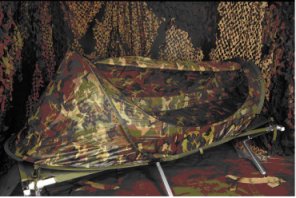
Product: The SS-LP bednet (NSN 3740-01-516-4415) is specifically designed for short-term use by highly mobile forces (e.g. infantry, Rangers, Special Forces, etc.). This lightweight, self-contained shelter that includes an internal, self-supporting flexible vinyl ester/fiberglass frame, a waterproof floor, rip-stop fabric, two zippered doors, mesh top, and flame-retardant materials. The frame pops open automatically from a 12 inch diameter backpack package so that the bednet is ready for immediate use on bare ground or over a standard military cot or hospital bed. The tightly woven mesh excludes even the smallest insects (e.g. midges and sandflies), and all fabric is impregnated with EXPEL, an Environmental Protection Agency approved permethrin-based insecticide. Infra-red signature, forest and desert camouflage patterns, and carrying capacity are compatible with military requirements. 
Application/Target microorganism/associated disease: Bednets can provide excellent protection against arthropod-borne diseases such as malaria, dengue, and leishmaniasis -- all force-degrading infections for which no vaccines are available. In malaria-endemic areas, regular use of insecticide-treated bednets (ITNs) can reduce childhood mortality by approximately 20% and cut severe disease by approximately 50%. Reasons for Development: The standard insect bednet (NSN 7210-00-266-9736) has been in existence for many years but has a variety of limitations: (1) not impregnated with an arthropod repellent (2) requires four 36" poles to set up for use on military cots and (3) must be completely tucked in on all sides to prevent biting insects from entering. Role of Department of Defense in product development: DoD has long been involved in developing and testing bednets. DoD has also participated in testing permethrin, an insecticide/repellent applied to bednets in order to maximize bednet effectiveness in protecting personnel from biting insects. The SS-LP bednet was designed by Walter Reed Army Institute of Research (WRAIR) in collaboration with Breakthrough Technologies. The SS-LP bednet was compared with the Australian Defense Force (ADF) mosquito bednet, at Buka Island, North Solomons Province, Papua, New Guinea, in March 1999. Both bednets provided greater than 97.9% protection compared to unprotected personnel. Additionally, the insecticide-untreated SS-LP bednet provided better nighttime protection than the insecticide-untreated ADF bednet. Current status: Although the SS-LP bednet is better than the standard bednet, a new bednet suitable for extended deployments is needed because the SS-LP bednet is relatively small, can block air flow, and may create a feeling of claustrophobia. Because current commercially available bednets currently have a relatively large mesh and are too bulky and unwieldy for use by U.S. forces, WRAIR is developing a new insecticide-treated bednet. The U.S. military requires a small, lightweight, bednet that is easy to set up and use that will protect service members from arthropods transmitting diseases and inflicting nuisance-biting. The new bednet will be constructed of durable high-denier polymer to protect against all biting insects, but with a mesh large enough to permit air flow. The insecticide will either be impregnated into the polymers before fiber extrusion or mixed in a resin which coats the net fibers so a constant supply of insecticide will be available at the surface of the net (rendering re-treatment with insecticide after washing or prolonged exposure to direct sunlight/ultraviolet radiation unnecessary). The net will accommodate a standard military cot, and be sufficiently tall to enable a soldier to sit comforably on top of the cot. Also, the new bednet will have a zippered entrance that can be operated from inside or outside the net, include self-contained flooring, be erectable in less than 5 minutes, and weigh less than 3 pounds. The collapsible frame will be constructed of flexible but durable poles. Commercial partners include Vesteraard Frandsen and Valent Biosciences. References: Asidi AN, N'Guessan R, Hutchinson RA, Traore-Lamizana M, Carnevale P, Curtis CF. Experimental hut comparisons of nets treated with carbamate or pyrethroid insecticides, washed or unwashed, against pyrethroid-resistant mosquitoes. Met Vet Entomol 2004 Jun 18 (2):134-140. Erratum in: Med Vet Entomol 2004 Dec 18(4):453. Curtis CF, Myamba J, Wilkes TJ. Comparison of different insecticides and fabrics for anti-mosquito bednets and curtains. Met Vet Entomol 1996 Jan; 10(1)1-11. Frances SP, Cooper RD, Gupta RK, Debboun M. Efficacy of a new self-supporting low-profile bednet for personal protection against Anopheles farauti (Diptera: Culicidae) in a village in Papua New Guinea. J Med Entomol 2003 40(1): 68-72. Gimnig JE, Kolczak MS, Hightower AW, Vulule JM, Schoute E, Kamau L, Phillips-Howard PA, Ter Kuile FO, Nahlen BL, Hawlet WA. Effect of permethrin-treated bed nets on the spatial distribution of malaria vectors in Western Kenya. Am Soc Trop Med Hyg 2003 68(Suppl 4): 115-120. Lindsay SW, Adiamah JH, Miller, JE, Armstrong JRM. Pyrethroid-treated bednet effects on mosquitoes of the Anopheles gambiae complex in The Gambia. Med & Vet Entomol. 1991 5:477-483. USAID. International conference on bednets and other insecticide-treated materials for the prevention of malaria, October 29-31, 1997, Washington, DC. United States Agency for International Development (USAID) Publication. 1997. 134 pp. |
| Extended Duration Insect Repellant | SS-LP Bednets | Premethrin Insecticide |
